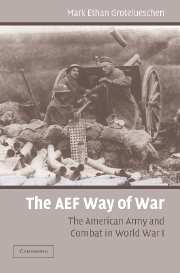Book contents
- Frontmatter
- Contents
- Acknowledgments
- Introduction
- 1 Doctrine, Dogma, and Development in the AEF
- 2 The 1st Division: Training for and Waging Trench Warfare
- 3 The 1st Division: The Search for a “Sufficiently Powerful Fire”
- 4 The 26th “Yankee” Division: Doctrine, Discipline, and Discrimination
- 5 The 26th “Yankee” Division: Doctrine, Demoralization, and Disintegration
- 6 The 2nd Division: Bloody Lessons in “Open Warfare”
- 7 The 2nd Division: The Rise of Set-Piece Battle
- 8 The 77th “Liberty” Division: Training for the Trenches and Fighting on the Vesle
- 9 The 77th “Liberty” Division: Dogma, Delegation, and Discretion
- 10 Conclusions
- References
- Index
10 - Conclusions
Published online by Cambridge University Press: 29 August 2009
- Frontmatter
- Contents
- Acknowledgments
- Introduction
- 1 Doctrine, Dogma, and Development in the AEF
- 2 The 1st Division: Training for and Waging Trench Warfare
- 3 The 1st Division: The Search for a “Sufficiently Powerful Fire”
- 4 The 26th “Yankee” Division: Doctrine, Discipline, and Discrimination
- 5 The 26th “Yankee” Division: Doctrine, Demoralization, and Disintegration
- 6 The 2nd Division: Bloody Lessons in “Open Warfare”
- 7 The 2nd Division: The Rise of Set-Piece Battle
- 8 The 77th “Liberty” Division: Training for the Trenches and Fighting on the Vesle
- 9 The 77th “Liberty” Division: Dogma, Delegation, and Discretion
- 10 Conclusions
- References
- Index
Summary
After the armistice of 11 November 1918, all American officers proudly agreed that the AEF had played a crucial role in winning the war. Developing from a small, poorly organized, inadequately equipped, and intellectually unprepared force, the U.S. Army had sent two million men to Europe, organized and equipped itself for modern combat, and bravely delivered powerful attacks against a much more experienced enemy. American officers were convinced that the AEF had provided the margin of victory for the Allied armies. There was less agreement on the role that U.S. Army doctrine had played in bringing about that victory. Although GHQ attempted to develop and disseminate doctrine, including some important tactical reforms, the most significant adaptation occurred within the individual combat divisions.
The Role of Pershing and GHQ
Despite the increasing doctrinal and operational independence of the AEF combat divisions, Pershing and GHQ were far from irrelevant – a charge sometimes leveled at some senior commanders in the French and British armies. Yet, few studies of the AEF, whether positive or negative accounts, have shown the nature of GHQ's relevance to American combat on the Western Front, or the limits of that significance. First, GHQ initially established an inadequate doctrine and then modified that doctrine more slowly and less completely than officers in the combat divisions. This initial acceptance of prewar American doctrine, and GHQ's continuous stress of the importance of that doctrine, meant that combat officers who accepted the instruction often employed faulty tactics during inadequately supported attacks based on poorly prepared attack plans.
- Type
- Chapter
- Information
- The AEF Way of WarThe American Army and Combat in World War I, pp. 343 - 364Publisher: Cambridge University PressPrint publication year: 2006



